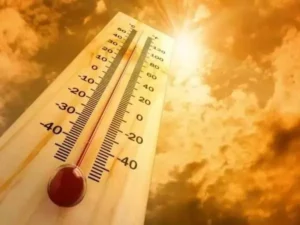
Why in news?
- The India Meteorological Department (IMD) has issued a warning about the upcoming summer season, predicting prolonged heatwave spells across various regions of the country from April to June.
- This comprehensive forecast aims to provide insights into the expected weather conditions and their potential impacts on different parts of India.
IMD’s Heatwave Forecast:
- The IMD’s forecast suggests that a significant portion of India will experience harsh and arid conditions during the summer months, with heatwave episodes lasting anywhere from 10 to 20 days.
- This extended duration of intense heat poses challenges for public health, agriculture, and overall well-being.
Regional Outlook:
- The forecast highlights specific regions expected to be affected by high temperatures, including Madhya Pradesh, Maharashtra, Karnataka, Kerala, Telangana, Andhra Pradesh, and Odisha.
- These areas are likely to witness above-normal maximum temperatures, exacerbating the heatwave conditions.
- Andhra Pradesh, Saurashtra-Kutch, Maharashtra, and western regions of Madhya Pradesh are projected to experience heatwave spells lasting 2 to 8 days, significantly higher than the usual duration.
Pre-Monsoon Rainfall Trends:
- The IMD’s forecast also addresses pre-monsoon rainfall patterns, indicating below-average rainfall in coastal India, eastern and southern peninsular regions.
- This prolonged dry spell since February adds to the overall aridity and water scarcity concerns, further intensifying the heatwave conditions.
Impact on Temperature
- Mrutyunjay Mohapatra, Director General of IMD, highlights the likelihood of above-normal maximum temperatures across most regions during the summer season.
- However, certain areas like Jammu and Kashmir, Himachal Pradesh, northern Odisha, and eastern India may experience normal or below-normal temperatures.
El Nino Influence:
- The forecast also considers the influence of El Nino conditions on India’s weather patterns.
- Although El Nino conditions have begun to ease after peaking in December, they continue to contribute to warmer temperatures globally and suppress rainfall over India.
- Mohapatra explains that El Nino years often result in higher-than-normal heatwave occurrences, emphasizing the need to monitor global climate phenomena for accurate weather predictions.
Future Outlook:
- Global climate models indicate that El Nino conditions are expected to transition to El Nino Southern Oscillation (ENSO) neutral conditions by June, coinciding with the onset of India’s southwest monsoon.
- This transition may bring relief from prolonged heatwave conditions.
Conclusion:
- As India braces for the impending summer season, IMD’s comprehensive forecast serves as a valuable resource for policymakers, authorities, and the public to prepare for and mitigate the impacts of extreme heat.
- By understanding the regional variations in temperature and rainfall patterns, stakeholders can implement effective strategies to safeguard public health, agriculture, and infrastructure against the adverse effects of prolonged heatwaves.
People also ask
Q1: What is the India Meteorological Department (IMD) forecasting for the upcoming months?
Ans: The IMD is forecasting a harsh and arid summer over a majority of regions in India during April to June.
Q2: What is the duration of the predicted heatwave spells?
Ans: The IMD predicts heatwave episodes lasting as long as 10 to 20 days during the April to June period.
Q2: Which regions are expected to experience above-normal temperatures?
Ans: Most regions in the country are expected to experience above-normal maximum temperatures during the summer season.
Q3: Which areas are likely to be affected by heatwaves this month?
Ans: Heatwave spells lasting for 2 to 8 days are most likely to affect Andhra Pradesh, Saurashtra-Kutch, Maharashtra, and western regions of Madhya Pradesh this month.
Q4: What is the expected performance of pre-monsoon rainfall?
Ans: The pre-monsoon rainfall performance is anticipated to be below average, particularly over coastal India, eastern, and south peninsular India.
Q5: Which regions are likely to experience normal or below-normal temperatures?
Ans: Jammu and Kashmir, Himachal Pradesh, northern Odisha, adjoining Gangetic West Bengal, and eastern India regions could experience normal or below-normal temperatures.
Your article helped me a lot, is there any more related content? Thanks!
Your article helped me a lot, is there any more related content? Thanks!
Can you be more specific about the content of your article? After reading it, I still have some doubts. Hope you can help me.
I don’t think the title of your article matches the content lol. Just kidding, mainly because I had some doubts after reading the article.